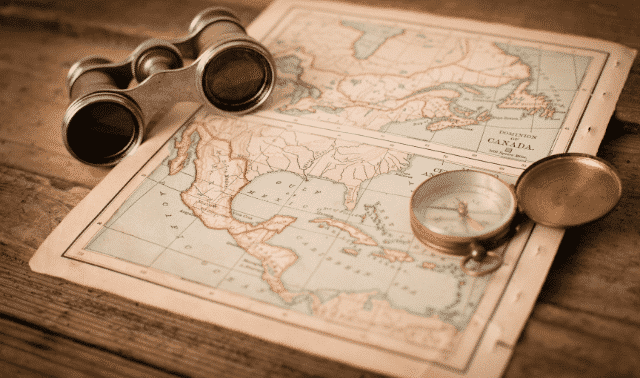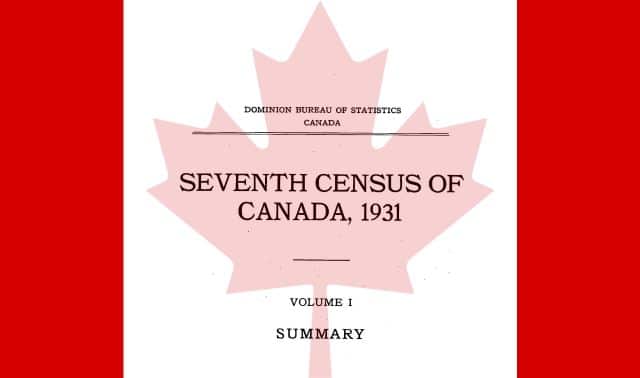Sign up for the Family Tree Newsletter Plus, you’ll receive our 10 Essential Genealogy Research Forms PDF as a special thank you!
Get Your Free Genealogy Forms
"*" indicates required fields
Canada is a nation of immigrants. Yet the stories of those who populated its prairies and provinces are often overshadowed by American tales of the Mayflower and the millions of arrivals at Ellis Island. When tracing migrations to North America, the Canadian “how they got here” stories are just as compelling.
Over the centuries, countless immigrants from the British Isles, Eastern Europe, Asia and, yes, even the United States, have answered the call to Canada. Some stayed to take jobs in cities or work on farms; others headed for Canada’s southern neighbor (maybe after sticking around awhile). It started with some 6,000 French immigrants who settled New France in the late 17th century and continues today as more than 400,000 immigrants arrive in Canada each year. Canada’s very character is defined by the successive waves of immigrants who settled in the Great White North.
No matter if your immigrant ancestors considered Canada home or a means to get to the United States—we’ll help you learn how they got there.
Quick History of Immigration to Canada
Research will invariably lead to ancestors who arrived in Canada from elsewhere. Canada’s earliest arrivals came from Europe. In the early 1600s, Samuel de Champlain, known as the Father of New France, convinced French investors and officials to support his exploration efforts. He founded a settlement in Quebec in 1608.
To offset the French fortress of Louisbourg in 1749, the British established Halifax. During and after the American Revolution, Loyalists (who’d taken Britain’s side) fled to Canada, where they could petition for land according to their rank. Many headed to Nova Scotia and Quebec.
In the early 1800s, while Britain was at war with France and the United States, arrivals to Canada slowed to a trickle. But that’s about when Scottish aristocrat Thomas Douglas (aka Lord Selkirk) sponsored settlements on Prince Edward Island, and on Hudson Bay Company land around the Red River in Manitoba. Once peace resumed, Britain encouraged immigration to protect its Canadian claims. Most British immigrants went to Upper Canada (now Ontario). Irish famine refugees flooded Saint John (now in New Brunswick) and Quebec between 1847 and 1852; it’s believed up to 5,000 died of typhus at a quarantine station on Grosse Île in the St. Lawrence River.
In 1885, the completed Canadian Pacific Railway linked Ontario to the western prairies. Canada looked to Eastern Europe for settlers to populate its land. By 1914, 170,000 Ukrainians lived in Canada; the majority in the prairie provinces. Free land in western Canada also attracted American farmers in the early 1900s.
In the 20th century, Canada’s population increased faster than that of any other industrialized country. Immigration peaked in 1913 and 1914, when Canada welcomed about 400,000, then World War I brought a sudden end to the movement of people. Immigration rose briefly in the mid-1920s. After the opening of Nova Scotia’s historic Pier 21 in 1928, almost almost one million immigrants arrived in Canada. However, the Great Depression in 1929 led to immigration policy reforms and curtailed the number of arrivals.
The essay Forging Our Legacy details Canadian immigration from 1900 through 1977. In previous centuries the majority of immigrants came from Europe. However, over the past 50 years, the number of new immigrants from Europe has declined, giving way to an increased share of new Asian and Middle Eastern immigrants. For more recent immigration information, consult the article published on Statistics Canada.
Other helpful resources include the Project Guttenberg eBook version of History of the Settlement of Upper Canada, the History of Upper And Lower Canada and Histoire des Canadiens-Français 1608-1880 (in French).
The best guide to Canadian immigration records is Destination Canada, by Dave Obee. Links to many of the online resources mentioned in the book can be found on Obee’s CanGenealogy website.
Preparing to Find Your Canadian Immigrant Ancestor
Researching in the world’s second-biggest country can be daunting. But here’s some good news: Canada has taken a leading role in putting key records online, many for free. Library and Archives Canada (LAC) has an excellent guide to these records in the Immigration Records section of its website which received a major makeover in 2022.
Before you dive in, though, it’ll help to learn the approximate year and port of your ancestor’s arrival. The largest Atlantic Canadian ports were Quebec and Montreal in the summer, and St. John and Halifax in the winter. On the western coast, which saw a lower volume of immigration, the main ports were Vancouver and Victoria, British Columbia.
Census Records
Censuses may provide clues. The 1931 Census of Canada, the seventh national census since Confederation in 1867, was undertaken on June 1, 1931, and is the most recent census available to researchers. The enumeration took several months to complete. People who died after that date were to be included, and children born after that date were to be ignored. The 1931 Census also asked for the Immigrant’s Year of Arrival in Canada and Year of Naturalization.
The 1931 census was opened for research on June 1, 2023 and is available to browse on the LAC website, where updates on indexing will be provided.
Enumerations from 1901, 1906 and 1911 and 1921 also indicate an immigrant’s year of arrival. LAC’s new free Census Search (in Beta) does not yet include the 1931 Census, but you can search all the other census years or select ones.
The subscription sites Ancestry.com and Ancestry.ca have the 1901, 1911, 1921, and several other censuses.
City Directories
No luck with the census? Try city directories: If you first spot a name in a 1910 directory, the person may have arrived that year. Directories are available at LAC facilities and at the FamilySearch Library in Salt Lake City, Utah (check for references to both online collections and those still on microfilm or microfiche.
Death Records
Death records (kept by provincial governments) sometimes say how many years the deceased resided in Canada. Land records are also helpful because immigrants often applied for land shortly after arrival. The national registration of all Canadian adults in 1940 asked for the arrival year. LAC offers help with all these records, too.
If the immigration date still eludes you, gather immigration data from documents such as church registers, local histories, tombstones and, especially for prominent individuals, newspapers in port cities. Use the FamilySearch Wiki for Canada for tips on finding other Canadian records.
Early Canadian Immigrant Records
Canada’s earliest official passenger lists date from 1865. But if your ancestors arrived earlier, you may find their immigration details in other documents. For example, you can search the LAC site for the names of 33,026 immigrants held at the Grosse Île Quarantine Station starting in 1832. In addition, the LAC’s Upper Canada and Canada West Naturalization Records database provides access to 2,967 references to the Upper Canada and Canada West Naturalization Registers from 1828-1850. held at Library and Archives Canada. The records are on microfilm at LAC and the included in a browsable digital images collection on FamilySearch (keyword search the FHL’s online catalog for Canada naturalization returns).
Other sources to check include:
- Ancestry.com offer millions of entries of searchable biographies, indexes, registers, and more. Use the Card Catalog feature to make sure you see them all.
- The Montreal Emigrant Society Passage Book lists 1,947 references to immigrants, most destined for Lower Canada (Quebec) and Upper Canada (Ontario), who received aid from the society in 1832. You’ll get a citation for the original record on microfilm at the LAC.
- Olive Tree Genealogy links to various online resources for passengers to Canada (scroll down to see the links). While the website’s original creator, Lorine McGinnis Schulze, has died, the site is currently still being maintained by her husband.
- The Provincial Archives of New Brunswick has a database of 23,318 Irish immigrants from 1845 to 1852. Also on the site, you will find information on Irish Immigrants in the New Brunswick Census of 1851 and 1861.
- The Ships List Provides information on the ships used by immigrants, with over 3,500 totally free access web-pages and a number of unique Canadian passenger lists.
Canadian Immigrant Passenger Lists
After 1865, passenger lists served as official records of immigration. The LAC holds surviving records from major ports on microfilm. You can view a list of ports covered, coverage dates and microfilm reel numbers. The FHL has copies of records covering 1900 to 1935, as well as earlier lists for Halifax and Quebec. Other Canadian libraries also may have film for various ports; see if your library can borrow film through interlibrary loan. Ancestry.com and Ancestry.ca have a name index and record images in a database called Canadian Passenger Lists 1865-1935.
LAC has put record images from 1865 to 1935 online. The free database includes about 28,000 records and is searchable by name. About 2,000 of the database entries are linked to digitized images. To search the database, click on the Collection Search link and then select “Advanced search.” In the “Search In” box pull down to select Genealogy and use All available online records. In All these words, enter a name. In Database, pull down the arrow to select “Immigrants before 1865” and for Year of immigration, enter a year or a range of years (optional). Click the Search button.
The new LAC website offers additional databases and search tools. On the Collections Search page, scroll down to the section “See our other databases and tools” and use the filter options drop-down menu to select “Genealogy and family history” and the Subtopic “Immigration” and “Database” for the type of guide. Click “Filter” to see a list of titles and descriptions. Since the site is in transition, when you click on a link to the collection name, for example, Passenger Lists for the Port of Quebec City and Other Ports, 1865-1922 you are taken to the old search pages which are still currently active.
The free Nanaimo Family History Society Passenger Lists Indexing Project covers Quebec ports (Montreal is included in the Port of Quebec) from July 31, 1903, to Oct. 13, 1910. Scroll down to choose an alphabetical range and open each index page as a PDF.
The indexing project was completed in June of 2013, when a decision was made not to include any new manifests.
If you can’t find your ancestor in an index, you can also search by name or browse through the images by port, month and year on FamilySearch (sign into your FamilySearch account and scroll down to Browse all records), or try Ancestry.
From 1919 to 1924, Form 30A replaced the use of passenger lists except for those in transit to the United States. For each immigrant, the form reported such details as the ship name, departure date, arrival date and port, name, age, occupation, birthplace, race, citizenship, religion, destination and the name of the nearest relative in the country of origin. In a version of Form 30A used in 1919, children were typically included with the head of household, not on separate forms.
Until about 1922, officials were inconsistent in using the form: Some names may turn up on Form 30A and in passenger lists, and some may appear only on a list. These forms are on microfilm at LAC and the FHL, arranged in rough alphabetical order: Surnames starting with the same few letters are grouped. Some common names, such as Smith and Adams, are grouped separately. The LAC’s Form 30A Web page links to a list of microfilm reel numbers by surname. Note that most forms were microfilmed back to front.
Search for immigrants from 1925 to 1935 in the LAC’s online name index to more than 830,000 names. The passenger lists from 1925 to 1935 have all been digitized and are now available online. First note the arrival date, ship’s name, volume, page and microfilm reel numbers. To view the actual page, consult Microform Digitization.
After 1935, passenger records are kept by Citizenship and Immigration Canada, and you can request copies.
More Resources for Finding Immigrants to Canada
If your ancestor belonged to one of the following groups, additional resources may provide immigration information:
- Chinese: Thousands of Chinese moved to Canada—mainly British Columbia—to prospect for gold and work on the Canadian Pacific Railway. In 1885, Canada imposed restrictions and a head tax on Chinese immigrants. An immigration ban replaced the tax in 1923, and Chinese immigrants already in the country had to register. The regulations were finally lifted in 1947. The LAC has a guide to researching Chinese immigrants to Canada.
- Home children: Between 1869 and the early 1930s, Great Britain sent more than 100,000 orphans to Canada. Search names of these home children taken from passenger lists can be found on the Library and Archives Canada website. Also, check the British Home Children Canada (BHCARA) Registry.
- Immigrants from the Russian Empire: From the mid-19th to the early 20th century, North American consulates for the imperial Russian government (which had control of eastern Poland, Finland, and most of the former USSR) kept records including passport applications and background questionnaires. Though many were lost, surviving records ended up with the US National Archives and Records Administration (NARA). The Canadian records, called the Likacheff-Ragosine-Mathers (LI-RA-MA) collection, has about 11,400 files dating from 1898 to 1922 on immigrants to Canada from the Russian Empire, including Jews, Ukrainians and Finns. You can download a PDF on this record series. Note that many of the records are in Cyrillic.
- The Irishman in Canada: This book by Nicholas Flood Davin offers a comprehensive history of the Irishman’s contribution to the establishment and development of Canada.
- Passenger Lists Leaving UK 1890-1960 are available to search on subscription site Findmypast to see if you can find your ancestor at the departure port. Conversely, the database. UK and Ireland, Incoming Passenger Lists, 1878-1960 (available to search via subscription at Ancestry.com) is an excellent source for finding people who returned to the British Isles to live or for a visit because it includes records of passengers arriving in the British Isles from Canada (and other non-European countries).
Records of Immigrants Crossing the US-Canadian Border
To this day, the world’s longest undefended border divides Canada and the United States. Migration across it was common; many folks went back and forth over decades. Immigrants often found it easier and less expensive to sail to Canada and journey overland to the United States. In fact, by the 1890s, steamship companies advertised passage to Canada to avoid the US government’s rigorous immigrant inspections.
Until 1895, border crossings in either direction weren’t recorded. Then the United States arranged with steamship and rail companies to track US-bound passengers. Most of these records have been compiled into the St. Albans Lists, named for the Vermont town where the US Immigration and Naturalization Service had its main office. The St. Albans lists, on microfilm at NARA and the FHL, cover all border crossings from 1895 to June 1917. From June 1917 until July 1927, they include crossings east of the North Dakota/Montana state line; and thereafter, they include crossings east of Lake Ontario. Border-crossing records are on FamilySearch and part of the immigration collections in Ancestry.com and Ancestry.ca.
Plenty of people bucked this trend, traveling north from the United States to Canada. Between 1901 and 1914, more than 750,000 entered Canada over the US border. Many were returning Canadians, but about one-third were European immigrants who’d originally settled in the American West. If your immigrant ancestor arrived at a US port before going north, look for him in The Statue of Liberty Ellis Island database covering the Port of New York. Ancestry.com’s Immigration Collection has surviving records of these and other US ports.
Before April 1908, Canada didn’t record arrivals across the US border. Even then, those who’d lived in Canada or had a Canadian parent weren’t recorded, nor were those who crossed where no port existed or when a port was closed. LAC has microfilmed border-crossing lists from 1908 to 1918. From 1919 through 1924, overland immigrants were recorded on Form 30A, similar to those who arrived on ships. FamilySearch has indexes and images of Canadian Immigration Records from 1919-1924.
LAC has Nominal Indexes of crossings from 1925 until 1935. However, some of the content is protected by third party copyright and may be restricted.
Immigration, Refugees and Citizenship Canada (IRCC) holds the records of immigrants who arrived from 1936 to the present. Library and Archives Canada does not have copies of those records. Use the links on the LAC to get an access request form.
Whether your ancestor was an early explorer, pioneer farmer, a fleeing Loyalist, or a determined immigrant passing through on his or her way to the United States, Canadian immigration records may hold the key to the “how they got here” mysteries in your family tree.
Related Reads
ADVERTISEMENT







